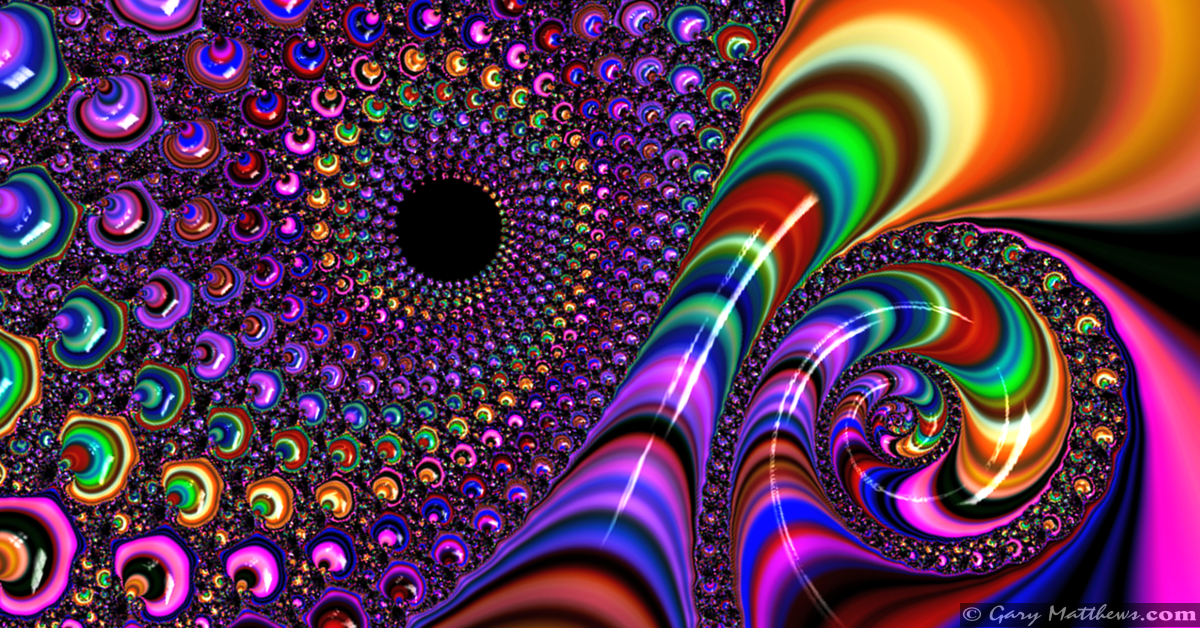Digital art. I’ve long been a sucker for it.
Lately I’ve been trying my hand at fractals, a particularly fascinating type of digital art. For me it started simply as puttering. Before I knew it, my hard drive was bursting with images. Some better than others. But all of them fun (for me, at least).
Here’s a sample: This one I’m calling Star Gate.

The Star Gate Story
Digital art is best shared with a story, or at least an evocative title. Here the premise is simple:
The Star Gate is powered by a massive collapsed star (“black hole“), shown at upper left/center. A spacecraft, guided into the gate, skirts the black hole’s “event horizon”. (That’s the point at which a collapsed star’s gravitational field becomes so intense that nothing, not even light, can escape.)
By skimming its surface, the starship avoids penetrating the event horizon. The resulting slingshot effect loops it around, at near lightspeed, into the wormhole tunnel shown at right.
Because the wormhole bypasses “normal” space, the spacecraft inside, without ever traveling faster than light, can emerge thousands of lightyears away after just a few months. From there it completes its journey using a simple Alcubierre Drive.
That, at any rate, is the story! Black holes are real. We don’t know whether wormholes are real, though Einstein’s relativity equations permit them. The Alcubierre Drive is better known to science-fiction fans simply as “warp drive”: It’s a speculative way of achieving faster-than-light travel by bending space. (NASA has a subcontractor conducting tests to find out whether it’s doable.)
My Digital-art Background
Back in the early Eighties, I purchased a TRS-80 Color Computer, and started experimenting. Among other things, it could display hypnotic, kaleidoscopic images in response to simple math inputs using the BASIC programming language.
Eventually I used BASIC (along with some rudimentary machine-language code) to construct a software utility called Chroma-Sketch. This was a drawing program that used the keyboard — or a mouse — to construct and color drawings using basic shapes such as lines, rectangles, and ellipses.
Although I even sold a few copies, Chroma-Sketch was soon rendered obsolete by packages like Adobe Illustrator and CorelDraw. It’s programs like these I use today (including the excellent free, open-source Inkscape, which I highly recommend).
Nevertheless, those early-Eighties experiments led to a computer graphics career that included advertising, business forms, book layout and design, and eventually web graphics. I’m also into photography, a different (though related) story.
Only recently did I become more than dimly aware of fractal art. The latter is generated using formulas that only the brightest mathematicians really understand. “Fractal” images are images in which the parts retain all the complexity of the whole, no matter how far you zoom in.
For example, consider a circle composed of 25 smaller circles. Each of these is composed of 25 still smaller circles, each of which — well, this pattern goes on forever. You can zoom to infinite depths, yet the circle(s) will look the same.
By varying the formulas and inputs, one can plot shapes of much greater complexity. Some fractal images are simply weird; many are of eerie, unearthly beauty. Few are boring.
Quite a few software programs have been developed to help artists generate fractals. I’ve experimented with Frax, Aphophysis, Ultra Fractal, the Fractal Science Kit, Tierazon, and a raft of others. (Please note: Some of these are free; others cost money or offer for-pay upgrades.) For the Star Gate image, I used Frax, a commercial program that runs on the iPad.
Whatever the source, I tend to embellish my results using other, non-fractal graphical programs such as GIMP, a photo-editing package, and the above-mentioned Inkscape. Fractal purists might call foul. Fortunately, I don’t mind.
If all goes well, I plan to post more fractal art. Perhaps even more background information to help understand what it is all about. Stay tuned!
Facebook Comments
Google Plus Comments
Richard Green, on 27 June 2014, was kind enough to post on Google Plus his own original article about the “Star Gate” image, along with a high-resolution version of the picture itself. His post garnered an astonishing 341 plus-ones, nearly 100 reshares, and almost 60 comments as follows:


